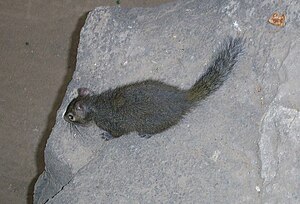Chinese red squirrel
| Chinese red squirrel | ||||||||||||
|---|---|---|---|---|---|---|---|---|---|---|---|---|

Pere david red squirrel ( Sciurotamias davidianus ) |
||||||||||||
| Systematics | ||||||||||||
|
||||||||||||
| Scientific name | ||||||||||||
| Sciurotamias | ||||||||||||
| Miller , 1901 |
The Chinese red squirrels ( Sciurotamias ) are a little-known genus of squirrels . The name relates to the North American red squirrels, whose close relatives they were previously believed to be (see below).
There are two types:
- Père David's red squirrel ( Sciurotamias davidianus ), low mountain range in central China
- Forrests red squirrel ( Sciurotamias forresti ), Yunnan
Forrests red squirrel was first assigned to its own genus Rupestes before it was united with the Père David red squirrel in Sciurotamias .
General
Both species inhabit rocky mountainous terrain, where they have a similar lifestyle as chipmunks seem to lead. They can climb trees but hardly ever use this skill. To rest they hide in crevices in the rock.
Chinese red squirrels have a head body length of 20 to 25 cm, with an additional 15 cm tail. The Père David red squirrel is gray on the top and white on the underside. The eyes are surrounded by pale rings. The Forrests red squirrel is gray-brown in color; A whitish and a dark brown line runs from the shoulders along the flanks, but these are sometimes barely noticeable.
Systematics
The generic name Sciurotamias expresses that these squirrels should occupy a middle position between the tree squirrels (Sciurini) and the chipmunks ( Tamias ); with the North American red squirrels ( Tamiasciurus ) they were long united in a common tribe Tamiasciurini. Since the 1960s they have sometimes been found together with chipmunks in the Tamiini tribe. Callahan and Davis carried out extensive morphological analyzes in 1982 and, because of some similarities in the sexual organs, came to the conclusion that Chinese red squirrels are related to the giant squirrels ( ratufa ). More recent classifications, however, together with the chipmunks, assign them to the tribe of real ground squirrels , which also includes marmots and ground squirrels . In the context of a revision of the chipmunks, however, the position within the Marmotini was not supported, whereby it is unclear whether the Chinese red squirrels are moved as sister taxons of the Marmotini or in the relationship of the tree and sliding squirrels (Sciurinae).
supporting documents
- ^ JR Callahan, R. Davis: Reproductive tract and evolutionary relationships of the Chinese rock squirrel, Sciurotamias davidianus. In: Journal of Mammalogy . Vol. 63, No. 1, 1982, pp. 42-47.
- ^ Richard W. Thorington Jr. , John L. Koprowski, Michael A. Steele: Squirrels of the World. Johns Hopkins University Press, Baltimore MD 2012; Pp. 298-300. ISBN 978-1-4214-0469-1
- ↑ Bruce D. Patterson, Ryan W. Norris: Towards a uniform nomenclature for ground squirrels: the status of the Holarctic chipmunks. Mammalia 80 (3), May 2016; Pp. 241-251 doi : 10.1515 / mammalia-2015-0004
literature
- Richard W. Thorington Jr. , John L. Koprowski, Michael A. Steele: Squirrels of the World. Johns Hopkins University Press, Baltimore MD 2012; Pp. 298-300. ISBN 978-1-4214-0469-1
- Michael D. Carleton, Guy G. Musser: Order Rodentia. In: Don E. Wilson , DeeAnn M. Reeder (Eds.): Mammal Species of the World. A taxonomic and geographic Reference. Volume 2. 3rd edition. Johns Hopkins University Press, Baltimore MD 2005, ISBN 0-8018-8221-4 , pp. 745-1600.
- Ronald M. Nowak: Walker's Mammals of the World. 2 volumes. 6th edition. Johns Hopkins University Press, Baltimore MD et al. 1999, ISBN 0-8018-5789-9 .